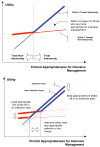PRODUCTIVITY SPILLOVERS IN HEALTHCARE: EVIDENCE FROM THE TREATMENT OF HEART ATTACKS
- PMID: 18418468
- PMCID: PMC2311510
- DOI: 10.1086/512249
PRODUCTIVITY SPILLOVERS IN HEALTHCARE: EVIDENCE FROM THE TREATMENT OF HEART ATTACKS
Abstract
A large literature in medicine documents variation across areas in the use of surgical treatments that is unrelated to outcomes. Observers of this phenomena have invoked "flat of the curve medicine" to explain these facts, and have advocated for reductions in spending in high-use areas. In contrast, we develop a simple Roy model of patient treatment choice with productivity spillovers that can generate the empirical facts. Our model predicts that high-use areas will have higher returns to surgery, better outcomes among patients most appropriate for surgery, and worse outcomes among patients least appropriate for surgery, while displaying no relationship between treatment intensity and overall outcomes. Using data on treatments for heart attacks, we find strong empirical support for these and other predictions of our model, and reject alternative explanations such as waste or supplier induced demand, for geographic variation in medical care.
Figures



References
-
- Arthur WB. Competing technologies, increasing returns, and lock-in by historical events. Economic Journal. 1989;99:116–131.
-
- Andersen HR, Nielsen TT, Rasmussen K, et al. A comparison of coronary angioplasty with fibrinolytic therapy in acute myocardial infarction. New England Journal of Medicine. 2003;349:733–742. - PubMed
-
- Beck Christine A, Penrod John, Gyorkos Theresa W, Shapiro Stan, Pilote Louise. Does Aggressive Care Following Acute Myocardial Infarction Reduce Mortality? Analysis with Instrumental Variables to Compare Effectiveness in Canadian and United States Patient Populations. Health Services Research. 2003;386:1423–40. - PMC - PubMed
-
- Coleman JS, Katz E, Menzel H. The Diffusion of an Innovation Among Physicians. Sociometry. 1957 December;20(4):253–270.
-
- Baicker Katherine, Chandra Amitabh. Medicare Spending, The Physician Workforce, and The Quality Of Health Care Received By Medicare Beneficiaries. Health Affairs. 2004a April;:184–97. - PubMed
Publication types
Grants and funding
LinkOut - more resources
Full Text Sources
